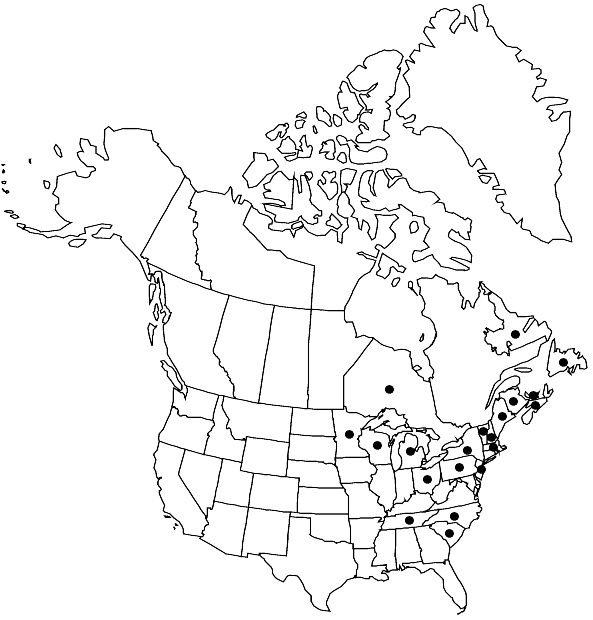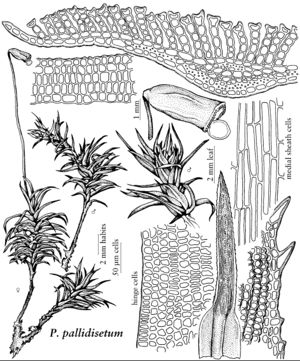Difference between revisions of "Polytrichastrum pallidisetum"
Mem. New York Bot. Gard. 21(3): 35. 1971,.
FNA>Volume Importer |
FNA>Volume Importer |
||
| Line 9: | Line 9: | ||
|name=Polytrichum pallidisetum | |name=Polytrichum pallidisetum | ||
|authority=Funck | |authority=Funck | ||
| + | |rank=species | ||
|publication_title=Krypt. Gew. Fichtelgeb. | |publication_title=Krypt. Gew. Fichtelgeb. | ||
|publication_place=3: 55. 1802 | |publication_place=3: 55. 1802 | ||
| Line 15: | Line 16: | ||
|name=Polytrichum decipiens | |name=Polytrichum decipiens | ||
|authority=Limpricht | |authority=Limpricht | ||
| + | |rank=species | ||
}} {{Treatment/ID/Synonym | }} {{Treatment/ID/Synonym | ||
|name=Polytrichum smithiae | |name=Polytrichum smithiae | ||
|authority=Grout | |authority=Grout | ||
| + | |rank=species | ||
}} | }} | ||
|hierarchy=Polytrichaceae;Polytrichastrum;Polytrichastrum pallidisetum | |hierarchy=Polytrichaceae;Polytrichastrum;Polytrichastrum pallidisetum | ||
| Line 41: | Line 44: | ||
-->{{#Taxon: | -->{{#Taxon: | ||
name=Polytrichastrum pallidisetum | name=Polytrichastrum pallidisetum | ||
| − | |||
|authority=(Funck) G. L. Smith | |authority=(Funck) G. L. Smith | ||
|rank=species | |rank=species | ||
| Line 55: | Line 57: | ||
|publication year= | |publication year= | ||
|special status= | |special status= | ||
| − | |source xml=https://jpend@bitbucket.org/aafc-mbb/fna-data-curation.git/src/ | + | |source xml=https://jpend@bitbucket.org/aafc-mbb/fna-data-curation.git/src/f50eec43f223ca0e34566be0b046453a0960e173/coarse_grained_fna_xml/V27/V27_162.xml |
|genus=Polytrichastrum | |genus=Polytrichastrum | ||
|species=Polytrichastrum pallidisetum | |species=Polytrichastrum pallidisetum | ||
Revision as of 20:59, 16 December 2019
Plants medium, dark green to blackish with age, in loose tufts. Stems 2–8 cm, simple, rarely branched, somewhat radiculose at or near the base. Leaves 6–10 mm, erect-spreading when dry, the blade spreading and recurved but not sharply reflexed when moist; sheath pale or yellowish, with tapering shoulders, hyaline-margined, the cells at the shoulders forming a differentiated hinge; marginal lamina plane or somewhat erect, 3–9 cells wide, sharply toothed from the apex almost to base of blade; blade lanceolate, sparsely toothed at back near the tip; costa excurrent, ending in short, reddish, toothed awn; lamellae (7–)20–40, crenulate in profile, 4–6 cells high, marginal cells often variable, in typically cuneate in section, flat-topped to shallowly retuse, not thick-walled, smooth; median sheath cells 80–100 × 8–12 µm (5:1), elongate-rectangular; sheath cells oblong-linear; cells of marginal lamina 12–16 µm, ± isodiametric; perichaetial leaves not much differentiated. Seta 2–8 cm, pale-yellowish. Capsule 3–5 mm, 4-angled, suberect to inclined, pale yellowish brown, slender and somewhat curved, tapering to the base, the hypophysis not or only weakly delimited; stomata in a band in the distal part of the hypophysis; exothecial cells not bulging or mammillose and without a central thin spot; peristome 240 µm, divided to 0.6, the teeth ca. 50, pale. Spores 12–16 µm.
Habitat: Soil, humus, rocks, moist coniferous or hardwood forests
Elevation: moderate to high elevations
Distribution

N.B., Nfld. and Labr., N.S., Ont., P.E.I., Maine, Mass., Mich., Minn., N.H., N.J., N.Y., N.C., Ohio, Pa., S.C., Tenn., Vt., Wis., c Europe (and Scandinavia), Asia (Altai Mountains, Caucasus Mountains, w China, Japan, Russian Far East).
Discussion
In eastern North America, Polytrichastrum pallidisetum is characteristically associated with spruce-fir forests, and areas formerly occupied by boreal coniferous forest and now occupied by mixed forests of the Northern Hardwoods type. An anomalous J. Macoun collection, ostensibly from British Columbia, is almost certainly from Cape Breton, Nova Scotia. G. S. Derda et al. (1999) interpreted both this species and P. ohioense as allopolyploids, possibly intergeneric hybrids between a Polytrichastrum parent and a Polytrichum parent. The lamella of Polytrichastrum pallidisetum are crenulate in profile, the marginal cells in cross-section truncate to shallowly retuse. Seen from above, the edges of the lamellae resemble a string of beads (moniliform), as compared with P. ohioense, in which the lamellar margins are entire in profile, and parallel-sided when viewed from above. The marginal cells in a given cross-section vary from retuse to flat-topped to slightly convex, but are never deeply notched, nor are they divided, as sometimes seen in Polytrichum commune. The lamellae of P. commune are taller, 10–12 cells high, and the median sheath cells are elongate-rectangular to linear (to 20:1), compared to short-rectangular (about 5–7:1) in Polytrichastrum pallidisetum. When capsules are present, the two species can be separated without difficulty.
Selected References
None.
